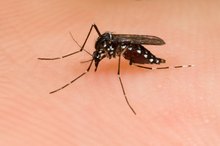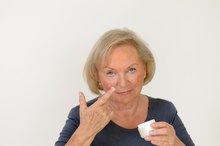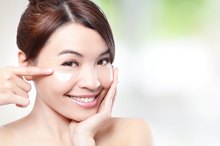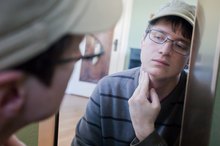What does fact checked mean?
At Healthfully, we strive to deliver objective content that is accurate and up-to-date. Our team periodically reviews articles in order to ensure content quality. The sources cited below consist of evidence from peer-reviewed journals, prominent medical organizations, academic associations, and government data.
The information contained on this site is for informational purposes only, and should not be used as a substitute for the advice of a professional health care provider. Please check with the appropriate physician regarding health questions and concerns. Although we strive to deliver accurate and up-to-date information, no guarantee to that effect is made.
How to Get Rid of Age Spots Naturally
Age spots, also known as liver spots, typically appear on the face, hands, shoulders, forearms and other areas of skin regularly exposed to the sun 1. According to the Mayo Clinic, age spots appear most frequently in adults over the age of 40, though they can also affect younger people 1. Despite their name, age spots are not caused by aging alone, but occur from long-term exposure to the sun or other sources of UV light. Considered harmless, age spots require no medical treatment. Bleaching with over-the-counter products or natural remedies may reduce their appearance.
Apply the juice from a fresh lemon to age spots at least twice per day to naturally reduce their appearance. Allow the juice to remain for 10 minutes before rinsing with warm water. Lemon juice contains mild acidic agents that may slough away dead cells from the skin's outer layer and lighten dark spots on the skin.
How to Get Rid of Freckles With Vitamin C
Learn More
Combine equal parts honey and plain, whole yogurt to create a mild, natural bleach that may lighten skin spots when used regularly. Apply directly to the skin, allow the mixture to dry for at least 30 minutes, then rinse clean with warm water. Repeat once per day for the best results.
Rub a piece of fresh pineapple over age spots to gently lighten their appearance. In her book “Ageless Natural Beauty,” Sally Freeman recommends performing this treatment at least once per day for the best results 3. Pineapple contains an enzyme called bromelain, which is a mild bleaching agent suitable for reducing age spots.
How to Make Grapefruit Juice Taste Better
Learn More
Apply aloe vera gel directly to age spots to help reduce their appearance. The Reader's Digest book, "1,801 Home Remedies: Trustworthy Treatments for Everyday Health Problems," recommends using gel fresh from the living plant, if possible 4. Aloe vera contains chemicals that gently remove dead skin cells and encourage the growth of new, healthy cells. Apply once or twice per day until you achieve the desired results.
Apply plain buttermilk, an old folk remedy for age spots, directly to the affected area once or twice per day to get rid of age spots. Buttermilk contains lactic acid, which gently exfoliates pigmented and sun-damaged skin while mildly bleaching.
Tips
While getting rid of age spots naturally is possible, it takes commitment and time to see results. Many natural remedies work slowly, over time, so stick with it and you should notice improvement in several days to weeks, depending on the severity of the condition. Avoid excess sunlight and always use sunscreen to prevent age spots from becoming dark again. Bleaching them with natural materials won't last permanently if you expose your skin to the elements that caused the damage in the first place. Try applying vitamin E oil to the skin after spending time in the sun to prevent the formation of age spots.
Warnings
Consult your physician before attempting remedies at home.
Related Articles
References
- Mayo Clinic: Age Spots (Liver Spots)
- University of Maryland Medical Center: Liver Spots
- “Ageless Natural Beauty”; Sally Freeman; 2002
- “1,801 Home Remedies: Trustworthy Treatments for Everyday Health Problems”; Reader's Digest; 2004
- American Academy of Dermatology. Variety of Options Available to Treat Pigmentation Problems. February 5, 2013. https://www.aad.org/media/news-releases/variety-of-options-available-to-treat-pigmentation-problems
- Tomecki J, Woodhouse G. Common Benign Growths. Cleveland Clinic Center for Continuing Education. http://www.clevelandclinicmeded.com/medicalpubs/diseasemanagement/dermatology/common-benign-growths/
- Scarcella G, Dethlefsen MW, Nielsen MCE. Treatment of solar lentigines using a combination of picosecond laser and biophotonic treatment. Clin Case Rep. 2018;6(9):1868-1870. doi:10.1002/ccr3.1749
- Scherer D, Kumar R. Genetics of pigmentation in skin cancer--a review. Mutat Res. 2010;705(2):141-53. doi:10.1016/j.mrrev.2010.06.002
- Bastiaens M, Hoefnagel J, Westendorp R, Vermeer BJ, Bouwes bavinck JN. Solar lentigines are strongly related to sun exposure in contrast to ephelides. Pigment Cell Res. 2004;17(3):225-9. doi:10.1111/j.1600-0749.2004.00131.x
- Davis EC, Callender VD. Postinflammatory hyperpigmentation: a review of the epidemiology, clinical features, and treatment options in skin of color. J Clin Aesthet Dermatol. 2010;3(7):20-31.
- George AO, Shittu OB, Enwerem E, Wachtel M, Kuti O. The incidence of lower mid-trunk hyperpigmentation (linea nigra) is affected by sex hormone levels. J Natl Med Assoc. 2005;97(5):685-8.
- Al-saif FM, Baqays AA, Alsaif HF, Alhumidi AA. Erythromelanosis follicularis faciei et colli with reticulated hyperpigmentation of the extremities. Clin Case Rep. 2017;5(10):1576-1579. doi:10.1002/ccr3.1095
- Dereure O. Drug-induced skin pigmentation. Epidemiology, diagnosis and treatment. Am J Clin Dermatol. 2001;2(4):253-62. doi:10.2165/00128071-200102040-00006
- Ammoury A, Michaud S, Paul C, et al. Photodistribution of blue-gray hyperpigmentation after amiodarone treatment: molecular characterization of amiodarone in the skin. Arch Dermatol. 2008;144(1):92-6. doi:10.1001/archdermatol.2007.25
- Jain A, Gupta N. Multifocal Bullous Fixed Drug Erruption Due To Phenytoin: A Lesson Learned! J Clin Diagn Res. 2015;9(12):OD04-5. doi:10.7860/JCDR/2015/15464.6908
- Mccarty M, Rosso JQ. Chronic administration of oral trimethoprim-sulfamethoxazole for acne vulgaris. J Clin Aesthet Dermatol. 2011;4(8):58-66.
- Massinde A, Ntubika S, Magoma M. Extensive hyperpigmentation during pregnancy: a case report. J Med Case Rep. 2011;5:464. doi:10.1186/1752-1947-5-464
- Sarkar SB, Sarkar S, Ghosh S, Bandyopadhyay S. Addison's disease. Contemp Clin Dent. 2012;3(4):484-6. doi:10.4103/0976-237X.107450
- Lause M, Kamboj A, Fernandez faith E. Dermatologic manifestations of endocrine disorders. Transl Pediatr. 2017;6(4):300-312. doi:10.21037/tp.2017.09.08
- Enguita FJ, Leitão AL. Hydroquinone: environmental pollution, toxicity, and microbial answers. Biomed Res Int. 2013;2013:542168. doi:10.1155/2013/542168
- Arora P, Sarkar R, Garg VK, Arya L. Lasers for treatment of melasma and post-inflammatory hyperpigmentation. J Cutan Aesthet Surg. 2012;5(2):93-103. doi:10.4103/0974-2077.99436
- Prohaska J, Badri T. Cryotherapy. StatPearls Publishing. 2019.
- Schalka S. New data on hyperpigmentation disorders. J Eur Acad Dermatol Venereol. 2017;31 Suppl 5:18-21. doi:10.1111/jdv.14411
- American Academy of Dermatology. Variety of Options Available to Treat Pigmentation Problems. February 5, 2013.
- Tomecki J, Woodhouse G. Common Benign Growths. Cleveland Clinic Center for Continuing Education.
Writer Bio
Willow Sidhe is a freelance writer living in the beautiful Hot Springs, AR. She is a certified aromatherapist with a background in herbalism. She has extensive experience gardening, with a specialty in indoor plants and herbs. Sidhe's work has been published on numerous Web sites, including Gardenguides.com.









